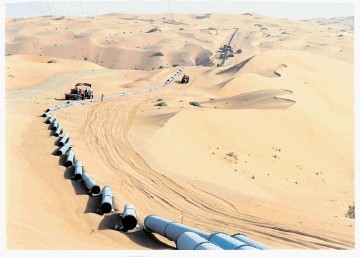
Saudi Arabia won’t balance global crude markets on its own even as prices fall “too low for everybody” and threaten the investment needed to meet long-term demand, the head of Saudi Arabian Oil Co. said.
The world’s biggest oil exporter, Saudi Arabia has the most spare capacity in OPEC and has historically played the role of swing producer, cutting its output to raise prices and pumping more barrels to lower them.
Oil prices have dropped 55% in the past year as rising production from the US and Russia helped global output exceed demand.
“Supply and demand and the rules of economics will govern. It will take time for the current glut to be removed,” Chief Executive Officer Khalid Al-Falih said at a conference in Riyadh.
“Saudi Arabia will not singlehandedly balance the market in a downturn,” he said, reiterating government policy.
The Organization of Petroleum Exporting Countries kept its production target unchanged at a November 27 meeting, seeking to defend market share rather than support prices as it keeps pumping close to 30 million barrels a day.
Saudi Arabia resisted calls from fellow OPEC members Venezuela and Iran to trim output. Saudi Oil Minister Ali Al-Naimi has said producers outside of the group should trim their output first.
Brent crude fell as much as 49 cents, or 1 percent, to $47.67 a barrel today, trading at $48.30 at 12:21 p.m. in London.
Brent has averaged at least $99 each year since 2011, according to data compiled.
Oil at close to $100 a barrel brought new production sources, like shale oil, to the market, pushing supply ahead of demand as growth in developing countries slowed, Al-Falih said.
The country is maintaining its output capacity while its exports are declining, so “imbalance in the market absolutely has nothing to do with Saudi Arabia,” he said.
Saudi Aramco is producing 9.8 million barrels a day, he said. That’s the most since at least October, data compiled shows.
The drop in prices will curb investment in the industry worldwide, Al-Falih said.
Saudi Aramco, as his company is known, will cut planned spending this year to less than its initial target, he said. State-owned Aramco plans to invest $30 billion to $50 billion a year to maintain crude output, transform itself into the world’s largest refiner and expand its trading and chemical businesses, Al-Falih said.
“To do that we need a price that is very, very healthy,” Al-Falih said. “It’s not a matter of recovering what we spent. It’s a matter of fueling an investment plan.”
Saudi Aramco’s cost to produce a barrel of oil is in the low single digits, he said. “Whether the price is $40 or $100, we’re not only covering our costs. We’re recovering the capital we invested.”
OPEC and the International Energy Agency, an adviser to 29 nations on energy policy, warn that a sharp decline in oil-industry investment will leave supply insufficient to meet demand.
OPEC Secretary General Abdalla El-Badri said yesterday that crude prices could reach $200 a barrel if spending dries up.
IEA Executive Director Maria Van Der Hoeven said last week that producers must invest more to satisfy a forecast need for 14 million barrels a day of additional crude by 2040.
Abu Dhabi in the neighboring United Arab Emirates is spending $90 billion to boost crude production and increase natural gas output.
Both the UAE and Saudi Arabia need more gas to meet industrial demand and burn as fuel in power plants.
Saudi Aramco plans to more than double investment in unconventional sources of natural gas, which are harder to find and extract than more typical deposits of the fuel, Al-Falih said.
Aramco has invested $3 billion to develop unconventional gas and plans to spend an additional $7 billion, Al-Falih said, without specifying dates for the actual or planned spending.
For more market info click here.
Recommended for you
